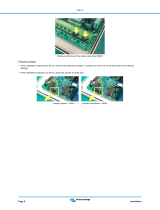
CS-702 TWO-CHANNEL MAIN STATION
1-7
The mic and headphone wiring in the headset cord must be individually
shielded. Do not connect pins #1 and #3 together. Headset extension
cords or headset “Y” cables are not recommended because they will
increase crosstalk between channels.
9. Earphone Jack: The jack marked earphone provides an output intended
to drive an extra earphone. This output is capable of driving a headphone
or loudspeaker.
10. Party Line Link Switch: This switch marked Party Line Link on the
front of the unit allows the operator to “combine” channels A and B so
that all stations can talk to each other. (Normally channels A and B are
totally isolated and stations on one channel cannot talk to stations on the
other channel.) When in the Party Line Link operating mode, only the
channel A controls operate. The channel B controls have no effect.
Note: When the switch is in the Party Line Link position, the channels
do not actually “combine.” What really happens is that the three
“B” channel connectors are simply internally disconnected from
the “B” circuitry and connected to the “A” channel circuitry,
putting all stations on the channel “A” party line. This maintains
all the correct line and station terminations.
Caution: The link function will work properly at the main station that is
providing the “line terminations” for the system. If there is
more than one main station in the system equipped with a
“link” switch, DO NOT ATTEMPT TO USE THE “LINK”
SWITCH ON THE STATIONS THAT ARE NOT
PROVIDING THE LINE TERMINATION. Both double-line
termination and station un-termination will result, causing
significant sidetone mis-adjustments and possible feedback and
oscillation.
11. Program Volume Control: The program volume control sets the amount
of the program signal heard directly in the headphone. This control only
affects what is heard in the headphone and does not affect program feed
to the intercom lines.
12. Announce Button: The announce button allows the operator to instantly
use the microphone input to directly talk to a system external to the
intercom such as a paging speaker/amplifier in another room. A dry set of
relay contacts on the rear panel is also available that can be used to
activate external switching as needed when the announce button is
pressed.
Pressing the announce button momentarily disables any active talks.
Active talk circuits will be restored when the button is released. The talk
muting action can be defeated if desired by moving an internal jumper
(refer to the section “Internal Options and Adjustments”).
13. Power Supply LEDs:
• NORMAL OPERATION: The talk buttons illuminate blue when the
station is receiving power.
• OVERLOAD AND SHORT CONDITIONS: A red D.C. Short light
indicates that an overload or short condition exists.
























